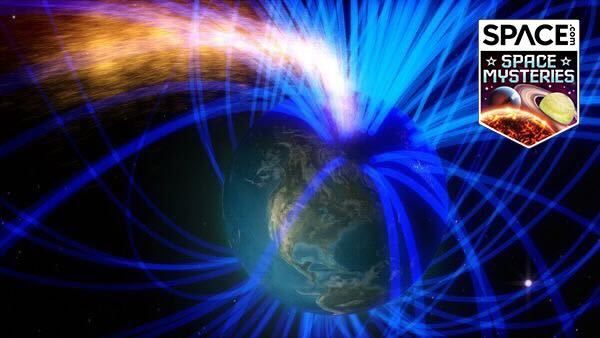
One of Earth's defining features is its magnetic field. It forms a protective shield against high-energy particles ejected by the Sun and thus arguably has provided life with a safer place to grow into the complex array of organisms we see today.
The most stunning indications of Earth's magnetic field are auroras, dancing curtains of colorful light that appear near the North and South poles during times of high solar activity. Another sign that Earth has a magnetic field is that a compass points north wherever you are on the planet.
But how can we tell if other planets or bodies in the solar system have magnetic fields? And is it possible to know if distant exoplanets have magnetic fields?
Related: Why do Earth's magnetic poles flip?
We know that the solar system's gas giants (Jupiter and Saturn) and ice giants (Uranus and Neptune) have strong intrinsic magnetic fields. However, it's a little more complicated for the terrestrial planets and moons, according to Joseph G. O'Rourke, a planetary scientist at Arizona State University.
Earth, Mercury and Jupiter's moon Ganymede all have internally generated magnetic fields today. Mars and Earth's moon have old crustal rocks that preserve remnants of magnetization from magnetic fields that existed early in their history, O'Rourke said.
As for Earth's other neighbor, "No intrinsic magnetism has been detected at Venus, but we haven't delivered instruments close enough to the surface to search for magnetized crust," he added.
For a magnetic field to exist on a planet or moon, a large volume of conductive liquid has to be in motion inside that body. A body could lose its magnetic field if those materials were to stop moving, or if there weren't enough of a temperature difference between the heating and cooling of materials to drive the convection of fluids inside a planet or moon, in which case the fluids would move too slowly, O'Rourke said.
In the case of Venus' apparent lack of a magnetosphere, there are four possibilities, according to O'Rourke.
The generally accepted idea is that Venus has an Earth-like core that is cooling too slowly. Because Venus lacks plate tectonics, its interior could be cooling more slowly than Earth's.

However, an alternative possibility is that Venus' interior is completely solid. This would require the planet's core to be far colder than Earth's, which O'Rourke thinks is unlikely. NASA's Venus Emissivity, Radio Science, InSAR, Topography and Spectroscopy mission planned for 2031 and the European Space Agency's EnVision mission will attempt to figure out if Venus' core is at least partially liquid.
Alternatively, Venus may lack an inner core. Earth's inner core helps generate our planet's magnetic field. As it crystallizes, it expels impurities (elements lighter than iron), which creates chemical buoyancy that drives fluid motions. Maybe Venus has not yet nucleated an inner core, so it's missing that extra power source.
The fourth possibility, O'Rourke said, is that Venus' core might be chemically stratified. The moon-forming impact might have stirred up ancient Earth's core, letting it generate a magnetic field when it started cooling. However, Venus has no moons, which might mean that nothing ever mixed up its core.
The best way to determine whether bodies in the solar system have magnetic fields is to have a spacecraft travel to the object to measure the magnetic field's intensity with a magnetometer. However, scientists were able to remotely detect Jupiter's magnetic field back in the 1950s by picking up radio emissions from the planet's auroras.
O'Rourke said magnetic fields are one of the best ways to learn about planets' interiors. The presence of a strong magnetic field tells scientists that the planet has a large reservoir of electrically conductive fluid that can move around.
"A dynamo is the process by which the energy of fluid motion is transformed into a magnetic field," O'Rouke explained. "In terrestrial planets, metallic cores can host dynamos, as in Earth today. However, liquid silicates (molten rocks, basically) are also electrically conductive at extreme pressures and temperatures. Hydrogen becomes metallic deep in the interiors of gas giants like Jupiter and Saturn, which enables their strong magnetic fields."
Do any exoplanets have magnetic fields?
When it comes to exoplanets — planets outside the solar system — planetary scientists have not unambiguously detected the presence of a magnetic field yet. However, O'Rourke thinks we aren't too far off. Astronomers have detected auroras, which arise from magnetic fields, in small stars known as brown dwarfs and low-mass M dwarfs.
"I would guess that the next generation of instrumentation will be able to detect magnetic fields from Jupiter-like exoplanets," O'Rourke said. "Detections of magnetic fields from Earth-like planets are on a more distant horizon, but hopefully achievable in the next several decades. In general, we can detect exoplanet magnetic fields directly (e.g., by observing aurorae or radiation belts) or indirectly (e.g., by observing the interactions of planetary magnetic fields with their parent stars)."
Planetary scientists are currently debating if magnetic fields overall protect planetary atmospheres. On one hand, magnetic fields can shield atmospheres from stellar winds, especially near the magnetic equator. On the flip side, magnetic fields can channel charged particles into polar regions, and a number of mechanisms that contribute to atmospheric escape are not strongly influenced by magnetic fields, O'Rourke explained.
"Earth has maintained both a magnetic field and habitable surface for billions of years," O'Rourke said. "Mars lost most of its water to space roughly when its magnetic field died. Venus, the hell world, lacks a magnetic field. In our solar system, magnetism is correlated with habitability. However, correlation is not causation."
As we get a larger sample size of exoplanets through observations with the James Webb Space Telescope, planetary scientists will start to reveal the relationship between magnetic fields and planetary habitability. Auroras might be one of the first indicators that we should look a little closer for signs of life.







